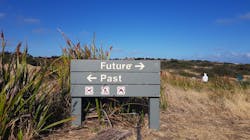The death of Mass Transit Founder and original Editor/Publisher Charles Carroll Carter in late May prompted a review of the magazine’s first issues from 1974.
Each issue carried a theme covering policy, funding for mass transit at the state level, lessons learned from abroad, how growing cities were meeting the challenge of moving more people and examining urban transportation development from the state capital viewpoint.
As entertaining as it was to see old hairstyles and boxy models of buses, once I started looking at the magazine’s coverage, it struck me how the challenges and discussions from 47 years ago run surprisingly parallel to those occurring in 2021.
While there was zero talk of pandemics in 1974, there was discussion of electric buses and it provides a nice contrast of how far they have evolved. From H.H. Flum’s “Electric-power vehicles: A return from the eclipse” that appeared in the November/December 1974 issue:
“…lead acid batteries store 35-50 kilowatt hours of energy and weigh between 3,500 to 4,500 pounds; a 50-gallon fuel tank weighs about 400 pounds and releases 50 times the equivalent BTU energy of a 4,000-pound battery…the 50-gallon fuel tank yields about five times as much energy as the battery but weighs about 1/10 as much.”
There were surprises, such as seeing the back cover of every issue occupied by a four-color ad from Gulf Oil Corporation with a headline that read “It’s time we made the choice. Mass transit, or mass confusion.” The oil embargo that had led to the 1973 energy crisis had lifted in March 1974 and the ad encouraged readers to keep private automobiles out of cities stating, “We can no longer afford to burn up millions of gallons of gasoline every day, just sitting in traffic jams.”
There were also jarring examples of less inclusive times. Pullman-Standard’s full-page ad encouraged finding the right modal balance by asking city officials and transit executives what they needed. However, it carried the following headline, “Ask the man who runs one” and ended with this text, “In our concern for solutions, we must consider all modes. And we should ask the men who run them.”
I’ll end (on a positive note) with a portion of a speech delivered by President Gerald Ford that is as appropriate today as when it was originally delivered at the 6th International Conference on Transportation in Pittsburgh, Penn., on Sept. 9, 1974:
“Our nation has to develop urban mass transit systems that people want to use. Until we develop those systems that offer convenience, comfort and reliability expected from the automobiles that Americans have been traditionally using, transit service even in our most congested urban areas will continue to be under-used.
“Today, with modern methods of movement, we have achieved miracles of mobility in America and in many, many parts of the world. But we have to maintain and expand the avenues of movement for all Americas, young and old, rich and poor.”
About the Author

Mischa Wanek-Libman
Group Editorial Director
Mischa Wanek-Libman is director of communications with Transdev North America. She has more than 20 years of experience working in the transportation industry covering construction projects, engineering challenges, transit and rail operations and best practices.
Wanek-Libman has held top editorial positions at freight rail and public transportation business-to-business publications including as editor-in-chief and editorial director of Mass Transit from 2018-2024. She has been recognized for editorial excellence through her individual work, as well as for collaborative content.
She is an active member of the American Public Transportation Association's Marketing and Communications Committee and served 14 years as a Board Observer on the National Railroad Construction and Maintenance Association (NRC) Board of Directors.
She is a graduate of Drake University in Des Moines, Iowa, where she earned a Bachelor of Arts degree in Journalism and Mass Communication.
